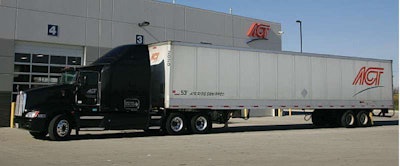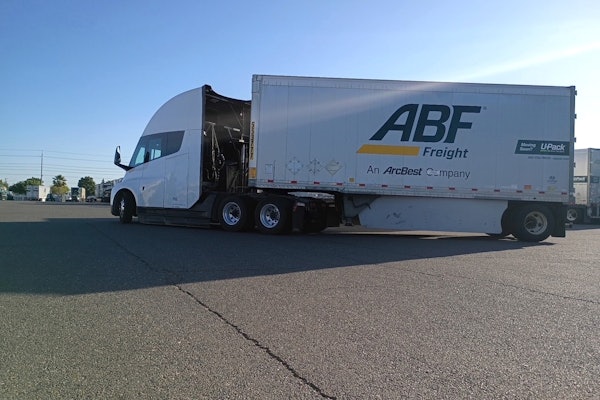American Central Transport
Liberty, Missouri
No stone unturned

During the recession, American Central Transport shrunk its fleet size to weather the slump in freight. But as the economy picks up and freight rebounds, the Liberty, Mo.-based company – like many carriers – faces the task of filling seats in an increasingly competitive driver market.
Prior to the recession, ACT offered many common strategies to attract and retain drivers, including referral and sign-on bonuses and elevated driver pay. This time around, however, the company realized it would have to take some new approaches to recruit drivers and improve driver performance to boost profitability.
Opening new doors
Adding to the challenge of finding drivers is ACT’s demanding qualifying process to hire top-echelon drivers without compromising its standards, which up until recently meant hiring only drivers with industry experience within the last year.
ACT developed a driver recruiting program targeting returning military veterans and former drivers and initiated a performance-based driver pay program
ACT realized it was discounting an entire subset of driver candidates – former drivers that left the industry during the recession that once again are looking for jobs and are calling the company’s recruiting office. “They wouldn’t qualify under our normal standards due to the length of time they’ve been off the road,” says Aaron Thompson, vice president of operations. “They may have 15 years of driving experience, but none of it is in the last three or four years.”
 American Central Transport’s goal for drivers entering the ACTivate Careers Program is to convert them to lease operators and independent contractors.
American Central Transport’s goal for drivers entering the ACTivate Careers Program is to convert them to lease operators and independent contractors.
With close proximity to several military bases in the Kansas City area, ACT also set its sights on military veterans returning from Iraq and Afghanistan with valid Class A commercial driver’s licenses that have experience in operating heavy equipment but not in an over-the-road environment.
In order to qualify these two new sets of driver candidates, ACT established the ACTivate Careers Program, a three-phase finishing school and career path designed to re-acclimate returning drivers to new technology and get discharged military CDL holders accustomed to a lifestyle in commercial trucking.
ACTivate begins with eligible drivers entering a five-day orientation program and classroom training on electronic logs, safety compliance and new truck technology. They then are paired with company driver trainers and hit the road for one- to two-week training sessions. “Technology has changed a lot in the last three to five years, and the trucks these guys were driving pre-recession are completely different in terms of technology and what the drivers are expected to understand in the cab,” says Thompson.
Upon successful completion of the finishing school, drivers are given a company truck and begin a 60-day probationary period. While new drivers sign on with ACT as company drivers, ACTivate provides a career path to convert them to lease operators and eventually independent contractors.
“Within six months, we can look at a driver’s performance and gauge if he understands what he has to do to run a business on his own,” says Thompson. “Based on how he scores as a company driver will tell us if he’ll be successful as an independent contractor.”
Paying for performance
Until this year, ACT always has paid company drivers at rates based largely on tenure, with incremental annual increases to reward loyal drivers. During the recession, however, the company began to look at company driver pay in an entirely new way.
ACT has been using driver scorecards to rate driver performance since 2008, assigning an A, B, C, D or F grade to each driver based on utilization, fuel consumption, safety performance and service levels to identify which drivers it wants to retain and which ones need counseling or it needs to let go.
“When we zeroed in on driver pay, what we found is some of the highest-paid drivers were our lowest-performing drivers, and some of our highest-performing drivers were on the lower end of the pay scale because they haven’t been with us long,” says Tom Kretsinger Jr., company president.
On Jan. 1, ACT rolled out its “pay for performance” company driver pay model in which company drivers no longer are paid by seniority, but by actual performance in five key categories. [See “ACT’s performance metrics.”] Every six months, ACT adjusts driver pay based on the driver’s scorecard from a range of 36 to 45 cents per mile; they will keep that pay rate until each six-month evaluation period ends.
To soften the transition in pay structure, ACT elevated the pay of its highest-performing drivers immediately, but didn’t lower driver pay for underperforming drivers until the July 1 reset date to allow them a chance to improve performance.
The theory, says Kretsinger, is to incentify everybody to become the best driver they can be in terms of the metrics that help improve safety and service levels and increase profitability. “If a guy drives 120,000 miles a year at 6 miles per gallon, he is burning 20,000 gallons. If he averaged 7 mpg, that comes to about 17,000 gallons. That’s $12,000 in fuel savings over the course of a year,” he says. Drivers that regularly use ACT’s fuel network also save the company an additional $5,000 per year.
“As I crunch the numbers, I want to pay my company drivers 45 cents per mile,” says Kretsinger. “The guy that is doing things right is well worth what we pay him. It is our hope that all drivers achieve the top level.”
To notify drivers of their performance during a six-month cycle, ACT provides drivers with midterm grades, identifying the metrics in which they need to improve in order to maintain or elevate their pay. “Midterms provide us with a good idea of who needs counseling,” says Thompson.
Kretsinger says the company saw immediate change in behavior once the program rolled out, including jumps in route compliance and fuel savings.
“I’m more conscientious,” says Dwight Manson, ACT company driver. “If you do a good job and hit all the points and make your deliveries on time, you feel like you are excelling. When a company takes care of you, you want to do a good job for them.”
And that is the exact response that Kretsinger and ACT want to hear.
ACT’s performance metrics
The rate at which company drivers are compensated is based on five key metrics that are most important to ACT:
Utilization (miles per week)
Fuel economy (average miles per gallon)
Safety (roadside violations, crashes, incidents)
Service (on-time pickup and delivery)
Route compliance (prescribed routing and fueling solutions)
CCJ Innovators profiles carriers and fleets that have found innovative ways to overcome trucking’s challenges. If you know a carrier that has displayed innovation, contact Jeff Crissey at [email protected] or 800-633-5953.













